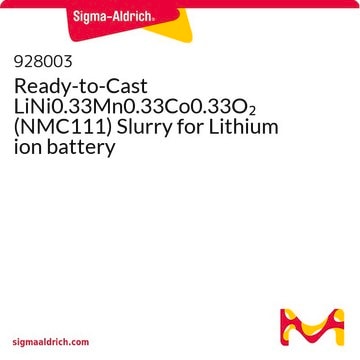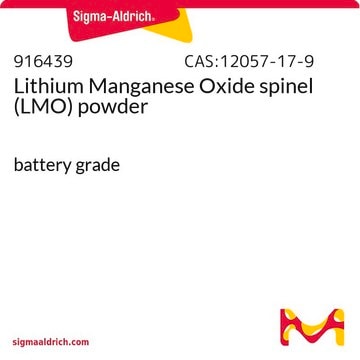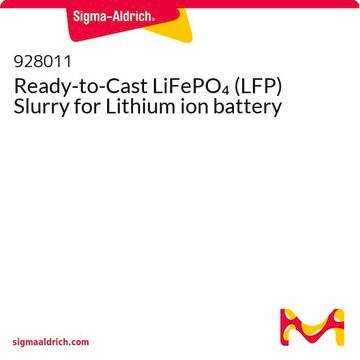推薦產品
等級
battery grade
描述
Nominal Voltage: 3.7 V, Li/Li+
化驗
≥98%
成份
loading, ≥80%
環保替代產品特色
Design for Energy Efficiency
Learn more about the Principles of Green Chemistry.
sustainability
Greener Alternative Product
標籤範圍
≥80% loading
尺寸
5 in. × 10 in.
厚度
12-25 μm
粒徑
10-13 μm (typical)
容量
150 mAh/g(minimum)
180 mAh/g(nominal at 0.1C)
mp
>1000 °C
應用
battery manufacturing
環保替代類別
, Enabling
一般說明
應用
The NCA casted electrode sheets can be cut into appropriate size and is ready to be used in lithium ion batteries.
其他說明
Operating Condiditons:
- Recommended maximum charge voltage: 4.3 V vs Li/Li+
- Recommended maximum charge current: 4C
- Recommended cut-off voltage for discharge: 3.0 V vs Li/Li+
- Recommended charge method: constant current - constant voltage
訊號詞
Warning
危險聲明
危險分類
Carc. 2 - Skin Sens. 1
儲存類別代碼
11 - Combustible Solids
水污染物質分類(WGK)
WGK 3
閃點(°F)
Not applicable
閃點(°C)
Not applicable
客戶也查看了
文章
Professor Qiao's review explores stable microstructures for lithium metal fluoride batteries, advancing energy storage technologies.
喬教授的評論探討了金屬氟化鋰電池的穩定微結構,推動了能源儲存技術的發展。
儘管處於早期開發階段,固體氧化物燃料電池和電解池仍顯示出化學能量轉換為電能的潛力。
Solid oxide fuel cells and electrolyzers show potential for chemical-to-electrical energy conversion, despite early development stages.
相關內容
Li-ion batteries are currently the focus of numerous research efforts with applications designed to reduce carbon-based emissions and improve energy storage capabilities.
The critical technical challenges associated with the commercialization of electric vehicle batteries include cost, performance, abuse tolerance, and lifespan.
Active Filters
我們的科學家團隊在所有研究領域都有豐富的經驗,包括生命科學、材料科學、化學合成、色譜、分析等.
聯絡技術服務















